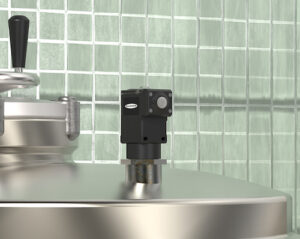Sensors for motion control range across many applications and uses; from object and position detection in manufacturing processes to remote condition monitoring for predictive maintenance purposes. Overall, the sensors are the vital link between the physical systems themselves. They collect data from various machine processes and use communication links to transmit that data to the cloud or other points of control or monitoring.
Generally speaking, sensors are following broader industry trends such as increasing data digitalization and the emergence of more robust communication networks. From a hardware perspective, advances in electronics means that sensors continue to get smaller. And as they’re increasingly digital, this means they can easily be integrated into many kinds of applications and systems via fast digital networks.

Tank level information is collected from multiple tanks by Q45UA all-in-one sensors and wireless nodes from Banner Engineering. The data is communicated over a Sure Cross wireless network to a DXM Series wireless controller, which makes the data available to other devices on network and can be configured to send text and email alerts.
Companies like Banner Engineering are on the front lines of these sensor trends. Specifically, as companies continue to look for ways to improve their processes, operate more efficiently, increase their productivity and lower expenses, they are investing in the latest sensor and networking technologies. Demand is rising in a range of industries including robotics, factory automation, off-highway applications as well as farming and fast food, among others.

A Q45UA all-in-one ultrasonic sensor and wireless node monitors the level or position of fluid or dry assets in tanks, totes, and containers.
To take one example: The IoT continues to shape both end-user requirements as well as sensor manufacturers’ offerings. This goes for the industrial IoT (or IIoT) as well. This is coupled with existing trends such as the digitalization of data that is driving more efficient control of processes including predictive maintenance and remote monitoring of all types of industrial and manufacturing processes.
Sensor companies are being responsive to these changes. For Banner Engineering, this means offering sensors with added capabilities. For instance, the company’s sensors are suitable for IoT and IIoT applications by supporting wireless networks on 900 MHz and 2.4 GHz frequencies as well as embedded cellular connectivity on 4G with Cat-M1. Such sensors are useful for condition monitoring applications used to monitor equipment and assets for a number of different parameters including vibration, temperature, humidity, pressure, position, and open/close status and others.
In fact, industrial applications for sensors are relying more on wireless connectivity. The advent of battery powered wireless nodes and sensors is allowing factories to easily scale hundreds even thousands of sensing points per facility. These devices are easy to use and feature advanced tools to provision networks, which eliminates the need for specialized knowledge to deploy devices and create an industrial wireless network.

Vibration, temperature, and current draw data gathered from a VT1 sensor and a current transformer from Banner Engineering is communicated by a CM Series condition monitoring node to a DXM Series wireless controller over a Sure Cross wireless network. Data can be used to track the health and performance of equipment and identify problems before a failure can occur.
Beyond data collection is the challenge of processing and interpreting such large quantities of data. In addition to the sensors themselves, companies like Banner offer edge analytics and machine learning as well as cloud software and reporting to help with data migration to big cloud providers.
The key is advanced signal processing at the sensor and gateway that limits the need to send large amounts of data. Sending just the right amount of data and limiting the amount of ‘on time’ for wireless networks means more efficient network communications and longer battery life. It also limits the amount of data that needs to be pushed over cellular networks and cloud infrastructure.
Filed Under: Factory automation, Motion Control Tips




